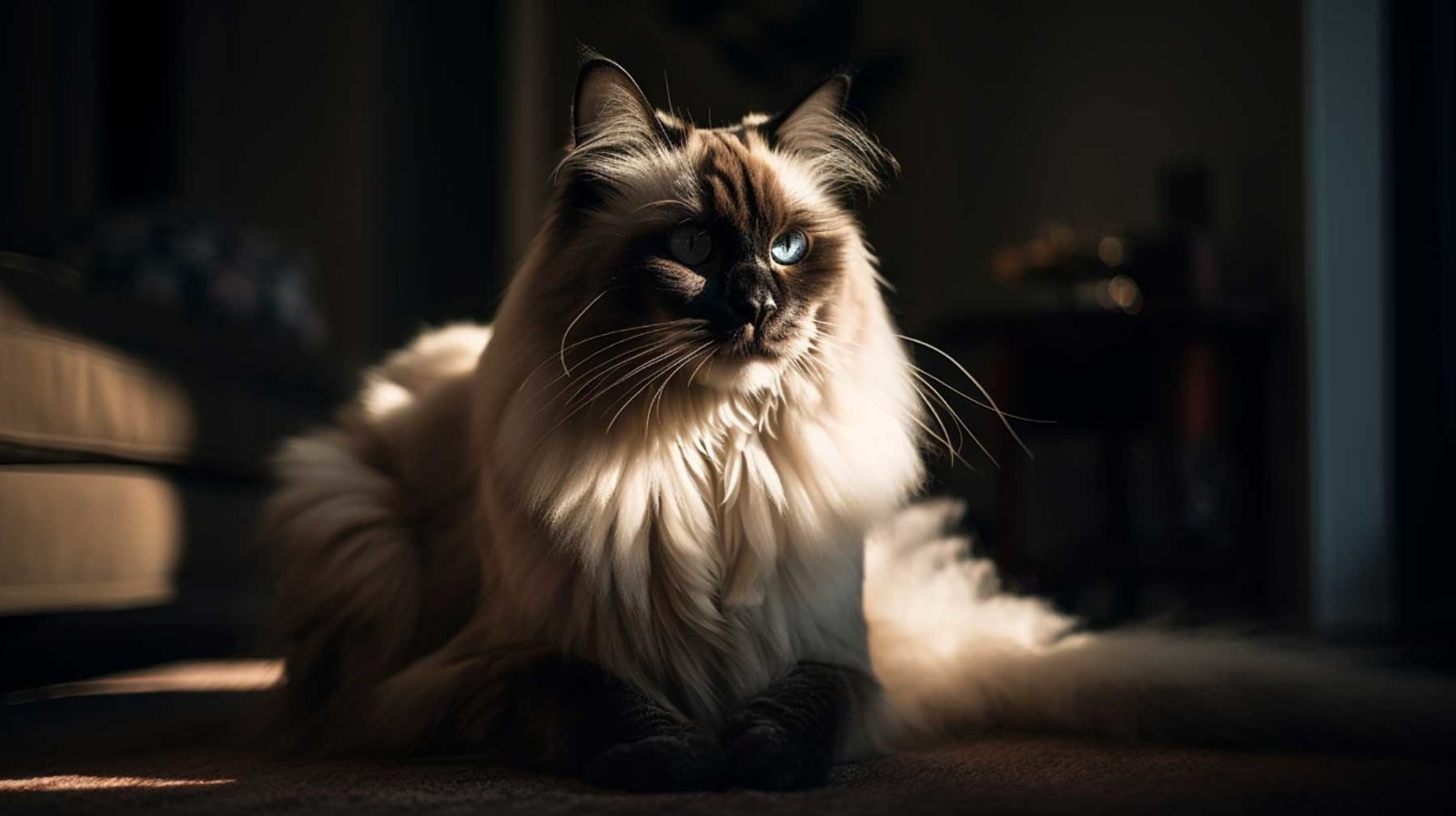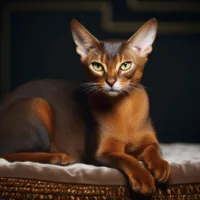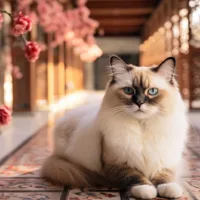Ragdoll look & fur – large, dreamy fluffy, and blue-eyed
The Ragdoll is one of the largest and heaviest cat breeds after the Maine Coon. It is not uncommon for it to tower over a medium-sized dog. Ragdolls are muscular and strong cats. Their large, round blue eyes, soft, thick, and plush fur, large, plump limbs, fluffy tail, and gigantic paws have helped this breed gain popularity.
Ragdolls are white at birth; it is after about two months that they have developed a visible pattern. The final coloration shows up after up to 4 years. Typical colors are red, seal, chocolate, blue, lilac, and cream in the patterns Colorpoint, Mitted, and Bicolor as well as the variations Lynx, Tortoiseshell (Tortie), and Tortoiseshell-tabby (Torbie).
Colorpoint – A color that darkens on the nose, ears, tail, and paws.
Mitted – Like Pointed, but with white paws and belly. With or without a blaze (a white line or spot on the face), they must have a white “belly stripe” and chin. Mitted Ragdolls are often confused with Birmans. The easiest way to tell the difference is by size (the Ragdoll is larger) and chin color (Mitted Ragdolls have white chins, while Birmans have colored chins). However, experienced cat experts and breeders can also tell the two by head shape and bone structure.
Bicolor – White legs, white inverted V on the face, white belly, and sometimes white patches on the back (excessive amounts of white or “high white” on a bicolor animal are known as the Van pattern, although this is nowhere near as common as the other patterns).
Variations:
Lynx – A variation with tabby markings accompanied by white inner ear margins in all patterns. Typical here is an “M” or “W” shape in the mask.
Tortie – usually red and black, but also cream, orange, or gold spotted or woven markings.
Torbie – patterns that have both tortoiseshell and tabby stripes.

A Ragdoll has a long, very soft, silky coat that can become extremely fluffy, especially in winter. However, it lacks the typical undercoat of fur. Therefore, she is not a great winter lover and thus snow-covered balconies are rarely interesting for long. In summer, however, she has fewer problems with heat than other long-haired cats. In addition, this circumstance ensures much less hair in the apartment.
Don’t misunderstand, we are still talking about a long-haired cat! So, owning a Ragdoll you won’t get around the one or other fur ball rolling through your apartment. Regularly used sleeping places will be steadily covered with a light layer of fur and also your clothes will at least let others assume that you have a cat for a friend. The typical “floof-imprint” on your sofa from a cat midst coat change sitting on it or a lint-infested hand after petting is not an issue with a Ragdoll, though. Even after extensive grooming, little to no hair remains in the brush. This does not make lint rollers completely irrelevant, but they do not have to be a constant companion or always at hand.
The maintenance effort of a Ragdoll is, therefore – considering it is a longhaired coat – also moderate. Regular brushing is not mandatory, but you should not ignore it completely, as matting can occur – especially in their dense, plushy fur collar.
Ragdoll health – addressing breed-specific risks
Like many large breed cats, Ragdolls are prone to weight and therefore joint problems. Purebred Ragdolls do not have much genetic diversity and are more susceptible than others. Kidney stones, bladder stones, and hypertrophic cardiomyopathy (HCM) can also occur and show up as blood in the urine. Making noises or crying in the litter box, straining to urinate, or urinating outside the litter box are other signs. We, therefore, recommend feeding food that is as moist as possible, as this has been shown to reduce the risk of kidney stones. Therefore, dry food should have no place in a cat’s diet.1
Hypertrophic cardiomyopathy is harder to prevent. HCM is a heart disease that causes thickening of the heart muscle. An echocardiogram can help diagnose the problem, but unfortunately only after the cat has developed HCM. Responsible breeders use genetic testing to try to avoid breeding cats with HCM, but there remains a residual risk. There is no cure once cats have developed HCM.



Ragdoll diet – fluffy titans need extra
Ragdolls are already larger as kittens than most other breeds and need particularly high-quality and nutrient-rich food to develop healthily and without deficiency symptoms. If you get your kitten from the breeder, it is in the middle of the growth phase at 6 months. In their first year of life, Ragdolls gain around half a kilo per month. It is not surprising that Ragdoll kittens are very voracious eaters and can easily eat more than a 380g can per day, even with high-quality food like Dynasty Emperor Ragout. In general, though, you should let growing kittens eat as much as they want. This prevents food envy and food stress later on, as they learn early on that there is always enough.
You don’t have to worry about obesity. Kittens eat as much as their bodies need nutrients to grow. As long as it is high-quality food with a prey-like composition, rich in meat and high-quality offal, obesity is virtually eliminated and there is no need to ration for either kittens or adult Ragdolls. Only if the composition of your food is not right, or it consists of grain, sugar, legumes, or other fillers, your floof ball’s body will get confused.
If the growth spurt subsides somewhat after the first birthday, the level will automatically settle at about a 375g can of Ragout per day. Ragdolls do not reach their full size until they are three to four years old. This is later than with other breeds, but since a Ragdoll cat can weigh 10 kilos, it takes time.
Ragdoll character – affectionate but energetic fluffy giants
The Ragdoll possesses a calm disposition and is known for her affectionate nature. Her famous trait is the tendency to go limp when lifted and hang down in a relaxed manner. Some Ragdolls literally fall into a trance. They behave like “ragdolls”, which is where the name comes from. Where this trait comes from is a mystery and not conclusively proven. Another characteristic is its very affectionate almost dog-like character. While other breeds are rather territorial, the Ragdoll attaches herself much more to her owners. Therefore, she often waits at the front door as soon as she hears that you are coming home and follows you from room to room. This sounds cute, but you have to realize: you don’t have much privacy with this breed. Needless to say, you’ll have to share your bed, too.
Ragdolls are very social cats.
They need company, either yours or ─ if home office is not an option ─ that of another cat. Regular playtimes are important, but Ragdolls are somewhat lazy by nature with very little stamina. Playtimes, therefore, tend to be short. If you are often on the road or at work, always leave a few toys lying around so your Floof can keep busy when you are not around. While you are at home, you should then join in the fun. By doing this you avoid behavior problems caused by boredom and increase the bond with you. By the way, a large number of Ragdolls love balls and even fetch.
The Ragdoll is a pure indoor cat. Due to her good-natured personality, she says “hello” to everyone and can easily get lost. She also doesn’t fight back when being picked up, which is why theft may become a problem. A cat that likes to be friends with everything and everyone is not very safe in the rough outdoors and needs to be protected from enemies. But you don’t have to lock her up. You can let her out in the garden under supervision, or if she can get used to a harness, you can take her for a walk. For some Ragdolls even the balcony is “too much nature” and they crawl inside at the first breeze.
Ragdolls are big cats, but still extremely agile with an impressive jumping height.
If a full-grown Ragdoll starts sprinting in the middle of its playtime, up to 10 kilos of fluff move through the apartment at up to 30 – 40 kmh (19 – 25 mph). A robust interior is a must! If you believe these heavy cats can climb only badly or do not jump particularly high, you are mistaken. They are certainly not the most agile cats, but heights of 1 ─ 1.2 m (3.2 – 3.9 ft) are reached without problems even from a standing position. Their size or weight also does not stop them from jumping down from refrigerators or from the top floor of your cat tree.
In order not to collapse during these climbing actions, your cat furniture should therefore be solid and heavy. If you don’t want to buy a new cat tree every few years, you should also choose high-quality from the beginning. If you don’t have room for a big tree, use one that can be attached to the wall or ceiling. Ragdolls also often “spill out” of standard beds because of their size. While some like to sleep that way, we also have extra large cat beds in our collection that dogs might feel comfortable in as well. Of course, the same is true for the litter box, which in standard sizes is neither high nor wide enough to “safely” accommodate a Ragdoll.
Ragdoll history – the secret behind her floppiness
The Ragdoll is quite new compared to many other cat breeds and was first bred in California in the 1960s by Ann Baker. Ann had taken over her neighbor’s litter, which came from her Persian/Angora cat Josephine and an unknown male (probably Birman, Siamese or similar). After an accident, Josephine had a peculiarity to completely relax physically when she was picked up. Of her kittens, some later exhibited the same trait and had become the origin of the breed.
No one could really confirm Ann Baker’s story about the creation of the Ragdoll cat as a happy accident of genetics. She insisted that her cats should be fed only with a special food prepared by her. There were therefore rumors from other breeders that Baker drugged her cats with an epilepsy and sedative drug, to produce the typical Ragdoll type. Even after later examinations, it was not possible to independently confirm this. Baker, however, was already notorious for her strongly inbred breedings before that.
The first Ragdoll
Thus the male Daddy Warbucks and the cat Buckwheat descended from Josephine’s first litters. The two were the first registered Ragdoll cats. Fugianna, the daughter of Josephine and Daddy Warbucks, joined them. Kyoto, a seal-mitted male, and Tiki, a seal-colored female, were from the cross between Daddy Warbucks and Buckwheat. Every Ragdoll cat in the world can be traced back to these first four cats.
[We] could find no physiological basis for the behavioral characteristics reported for the Ragdoll breed.
Dr. Merrill Mitler
Ann Baker’s dubious character also manifested itself in questionable behavior
She advertised her new breed as relaxed, docile, and incapable of feeling pain. She marketed this particular trait on television by throwing her cats through the air and even against walls. We discourage searching the web for legacy footage, as it can be disturbing. Baker sprinkled myths between facts in her lectures and used long-winded monologues with nonsensical digressions for effect. Listeners were also not spared disturbing metaphors such as the breeding of one-armed people and various racial theories. Baker said in an interview “It’s not what mother is, it’s not what daddy is, it’s what they have programmed her to produce.” Based on this statement, it is clear that Ann Baker tried at all costs to spin a legend around the characteristics of the Ragdoll in order to market it.
Various research universities, including Stanford and Loma Linda, attempted to research the breed’s typical traits in early 1973, but could not find any notable abnormalities. Finally, Stanford University’s sleep laboratory, which studies narcolepsy in animals, began investigating because of the Ragdoll’s legendary floppiness. Dr. Merrill Mitler examined brain waves, eye movements, and muscle activity of the cats’ necks, among other things. His investigation “could find no physiological basis for the behavioral characteristics reported for the Ragdoll breed.”
The fight for the Ragdoll trademark
Shortly thereafter, Baker sought to trademark the name Ragdoll and banned all traditional associations from selling cats under the breed name Ragdoll. She also charged overpriced fees to former buyers. This led to a break with the Ragdoll community at that time. Under the commitment of the couple Denny and Laura Dayton, they then organized a meeting of all Ragdoll breeders and in 1975 helped the breed to gain general recognition according to today’s Ragdoll standard and was thus able to avoid registration as a trademark.
In 1981, breeders imported the Ragdoll breed to the United Kingdom and expanded the breeding stock to infuse new blood into the lines. During this period, they also created the Chocolate and Lilac variants. Unfortunately, some breeders misunderstood and ignored them, mistaking them for poorly pigmented Seal and Blue variants, putting them at risk of being lost. In 1997, breeders officially recognized Colorpoint Ragdolls in the colors Flame, Cream, and Lynx-Point. In 1999, Mitted Ragdolls gained recognition, and in 2005, new colors such as Red, Cream, Tortie, and Lynx markings were acknowledged.
Suitable for cat beginners with city apartment and full-time work
- Experience level: Beginner
- Housing: Apartment
- Activity level: Low
- Energy level: Low
- Trainability: Medium
- Attachment: High
- Friendliness: High
- Playfulness: Medium
- Talkativeness: Medium
- Intelligence: High








